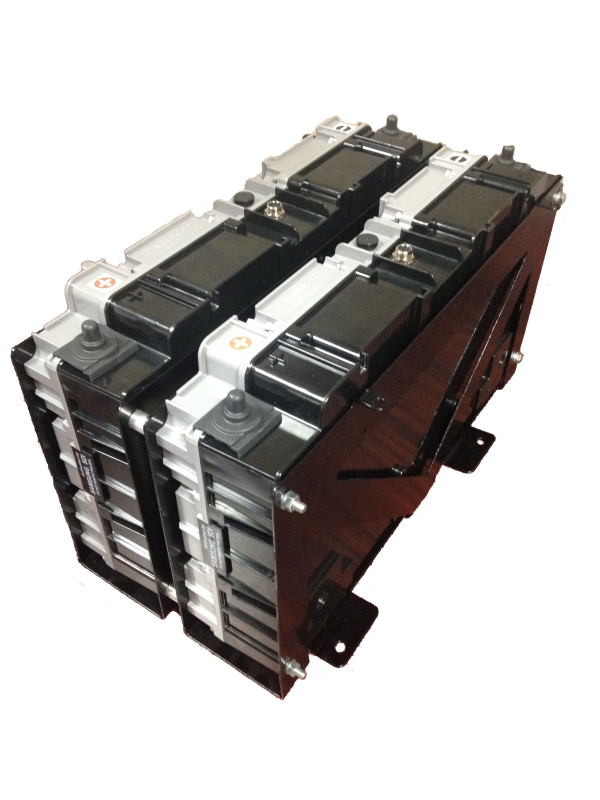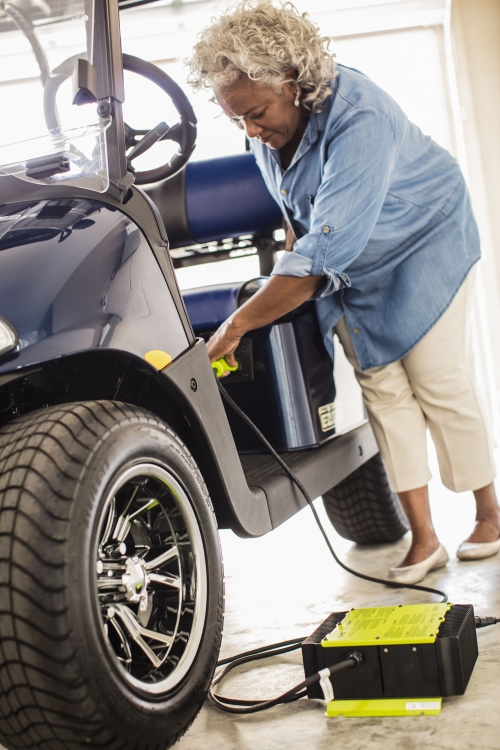writes Ella Boyden, PR and Communications Officer, Textron Specialized Vehicles
 The discussion about golf car batteries and the benefits of the various types has been ongoing for some time now. E-Z-GO is the first major golf car manufacturer to introduce a lithium-ion (li-ion) golf car and experts in the field of battery power share the consensus that li-ion batteries improve the performance and longevity of golf cars compared to traditional lead acid batteries. Consumers have also been quick to adopt the new technology with golf club managers and purse string holders realising that the benefits of li-ion golf cars ultimately outweigh the initial up-front costs.
The discussion about golf car batteries and the benefits of the various types has been ongoing for some time now. E-Z-GO is the first major golf car manufacturer to introduce a lithium-ion (li-ion) golf car and experts in the field of battery power share the consensus that li-ion batteries improve the performance and longevity of golf cars compared to traditional lead acid batteries. Consumers have also been quick to adopt the new technology with golf club managers and purse string holders realising that the benefits of li-ion golf cars ultimately outweigh the initial up-front costs.
A recent report by Technavio forecasts that the global golf cart battery market will grow at a compound annual growth rate (CAGR) of nearly 5% between 2017-2021. Another report by the market research firm Genpact said the global golf car demand will reach 214,000 units this year and that their installation rate for li-ion batteries will jump drastically from 1 percent last year to 14 percent this year. The li-ion battery installation rate on Korean golf cars has already surpassed 90 percent, according to the same report.
As aforementioned, E-Z-GO has capitalised on the trend in the market and has taken the lead in this field: “Vendors are expanding their current production capacities for lead-acid batteries. Samsung SDI has a contract with golf car manufacturer, E-Z-GO to supply its cylindrical battery, which is based on the li-ion battery technology.” says Thanikachalam Chandrasekaran, a lead analyst at Technavio for energy storage research.
This collaboration has resulted in the E-Z-GO ELiTE golf car series where the vehicles are powered by hundreds of Samsung SDI lithium cells that are loaded into a single battery pack. The battery pack is controlled by an advanced Battery Management System that monitors efficiency, temperature, state of charge and the health of the batteries.
“The golf course industry is witnessing a transformation, owing to the use of latest technologies. To enhance a golfer’s experience and attract new customers, golf clubs are integrating the latest models of golf cars…” Chandrasekaran says. It is no surprise that clubs are looking to enhance the golfing experience, given the competitive nature of the industry. A golfer will spend approximately 85-90 percent of their time in a golf car in many cases, so it seems that investing in golf cars is key.
Since the introduction of the ELiTE Series in 2017, it has been widely adopted by a range of clubs with vastly differing budgets including Princes Golf Club in Kent, U.K., and Real Club Valderrama in Spain, to name but a few. While clubs are realising the benefits of li-ion technology, there are still obstacles to overcome, and a big one is budget.
The cost of an E-Z-GO ELiTE golf car is approximately 20% dearer than the cost of an equivalent vehicle with a lead acid battery. This may seem like a hefty difference in price, but if you study the long-term financial savings as well as the time saved on maintenance and charging, the former soon becomes the more appealing option.
The benefits of li-ion technology have been broken down in the categories below to fully understand the myriad of benefits and the areas that have the most potential for making significant cost savings.
Weight
A golf car with a li-ion battery has a significantly enhanced power-to-weight ratio. Li-ion batteries are half the size of lead acid batteries and a fraction of the weight. To put a figure on this, a standard li-ion battery in an E-Z-GO ELiTE golf car weighs 23kg, compared to a standard lead-acid battery which weighs around 150kg. This dramatic reduction in weight and size of the battery means that the golf car can reach higher speeds with less effort and carry more weight without the power fading and the performance diminishing.

This huge weight saving allows the lithium-powered car to carry the equivalent of an additional two average-sized adults and their equipment before reaching capacity. This is made possible because lithium batteries maintain the same voltage outputs regardless of the battery’s charge. As a result, the golf car continues to perform after its lead-acid counterpart has shown signs of fatigue. In comparison, lead acid batteries lose voltage output and performance after 70-75 percent of the rated battery capacity is used, which has a negative impact on carrying capacity and the issue is highlighted as the day progresses.
Maintenance
One of the major benefits of li-ion batteries is that they require no maintenance whatsoever as opposed to lead-acid batteries which need regular checks and maintenance. This ultimately results in saved man hours and the extra costs of maintenance tools and products. The lack of lead-acid means that chemical spills are avoided and the chance of downtime on your golf cars is drastically reduced.

However, it is still important to take care of any vehicle or machinery to protect it for years of use. One of the biggest factors when it comes to the wear and tear of golf cars is the weight of them; a heavy vehicle is more of a challenge to drive uphill or on uneven terrain and can damage turf especially in wet conditions. The reduction in weight when using li-ion batteries protects turf and removes unnecessary stress on brakes and other components on the golf car.
Charging
This is an inevitable part of owning any vehicle powered by electricity. Regardless of the type of battery, electric vehicles still need to be charged. This can be an inconvenience if you do not have a fleet of golf cars or a schedule that allows time for charging in between uses.
Golf cars need to be able to maintain consistent power and speed on a range of terrains. Studies have proven that li-ion batteries are able to provide this consistency, but lead-acid batteries will have a negative impact on the performance of the golf car as the voltage dips.

On average, it takes eight hours to fully recharge a lead-acid battery. However, a li-ion battery can be recharged up to 80 percent its capacity in just one hour, and 100 percent in less than four hours. Another contrast between the two types of battery is that partially charge lead-acid batteries are susceptible to sulfation damage, meaning that if the golf car is charged to less than 100 percent, the life of the battery is significantly reduced. Conversely, li-ion batteries show no adverse effects of being charged less than capacity, meaning that users can “opportunity charge,” plugging vehicles in for quick charging sessions that can rapidly restore significant levels of energy to the battery system, as opposed to the lengthy recharge cycles required by lead-acid batteries.
Golfers will often pay good money to enjoy a round of golf, and in this day and age, it is unacceptable for a golf car to run out of juice half way through a round. Not only can it potentially ruin the golfer’s overall experience, but it drives much needed business away. For this reason, the importance of efficient and long-lasting battery life in golf cars cannot be understated.
Eco-Friendly
The E-Z-GO website states, “Driven by a zero-emissions, greener battery technology, ELiTE vehicles protect the Earth by using less energy.” This statement is supported by the fact that li-ion batteries take significantly less time to fully charge, and the life span of lithium-powered batteries is longer than lead-acid counterparts.
Li-ion batteries do not contain hazardous material, whereas lead-acid batteries, as the name suggests, contain lead which is harmful to the environment. However, both are recyclable which is only a positive thing for the environment.
Many golf clubs now have environmental policies in place, some of which are overseen by the Golf Environment Organisation (GEO) and other official bodies. The introduction of li-ion golf cars has given clubs another avenue to enhance environmental sustainability on the golf course in an industry that is always striving to reduce its carbon footprint.
To Conclude…
The longevity and performance enhancing capabilities of li-ion batteries somewhat outweighs the initial up-front cost that consumers are faced with. If golf clubs and private users can see beyond this, not only does the investment pay for itself over time, but big savings can be made in the way of reduced energy bills, maintenance costs, and possible repairs that would otherwise need to be made to heavy lead-acid golf cars and any damage to turf that they cause.
Furthermore, in a spate of recent lead-acid battery thefts at a number of golf clubs in the U.K., a li-ion battery is not valuable to thieves in terms of its content or the material it is made from. While it does not combat the underlying issue of criminal activity, it does at least reduce the chances of theft and the financial and legal impact associated with it.
In a market where the trend leans towards lithium technology being the way forward, there will no doubt be more and more manufacturers following in the footsteps of E-Z-GO and its introduction of the ELiTE series.
E-Z-GO https://ezgo.txtsv.com/

